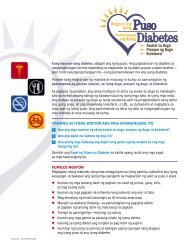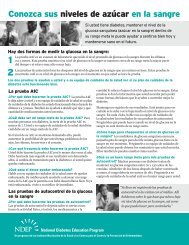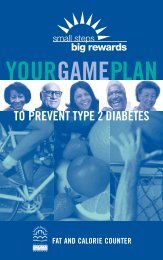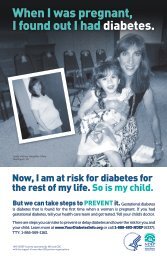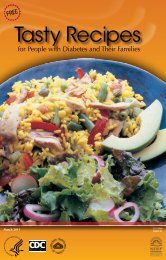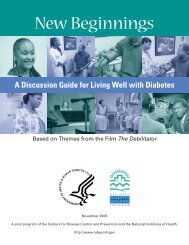Power to Prevent - National Diabetes Education Program - National ...
Power to Prevent - National Diabetes Education Program - National ...
Power to Prevent - National Diabetes Education Program - National ...
Create successful ePaper yourself
Turn your PDF publications into a flip-book with our unique Google optimized e-Paper software.
After the discussion, say: “Let’s fll out our Individual Progress Charts. This is the time <strong>to</strong> award<br />
stickers for achieving goals, making progress, and needing a helping hand.<br />
Give each participant a new Weekly Pledge form and a new GAME PLAN Food and Activity<br />
Tracker.<br />
Discussion Points<br />
Say: “Who knows the difference between a portion and a serving?<br />
Think of a ‘portion’ as the amount of a specifc food that you choose <strong>to</strong> eat for dinner or a snack or at<br />
any other time. A portion can be bigger or smaller than the recommended food serving.”<br />
Explain that a “serving” is a unit of measure used <strong>to</strong> describe the amount of food recommended<br />
from each food group. It is the amount of food listed on the Nutrition Facts panel on packaged or<br />
canned food or the amount of food recommended in the Dietary Guidelines for Americans created<br />
by the U.S. Department of Agriculture and the U.S. Department of Health and Human Services<br />
http://www.mypyramid.gov/.<br />
If you have plastic or paper food models available, use them <strong>to</strong> demonstrate serving sizes. Ask<br />
participants <strong>to</strong> estimate how many servings they typically consume when they eat some of their<br />
favorite foods.<br />
Say: “Eating fruits and vegetables as part of a healthy diet helps control blood sugar levels if you have<br />
diabetes, and can help you lose weight <strong>to</strong> prevent or delay diabetes if you are overweight. But many<br />
people don’t eat the vegetables they need!<br />
We’re going <strong>to</strong> talk about something that will help you get more vegetables in<strong>to</strong> your healthy diet. It’s<br />
called the Plate Method.”<br />
Hand out Appendix T: The Plate Method.<br />
“The Plate Method works by dividing a standard size (9-inch) plate in<strong>to</strong> sections and flling the<br />
sections with particular types of food. You can use the Plate Method as a guide for what and how<br />
much <strong>to</strong> eat at breakfast, lunch, and dinner. All you need <strong>to</strong> do is fll your plate so that it matches<br />
the Plate Method picture guide, add a piece of fruit and/or a glass of milk, and you are done. No<br />
piling the food high in<strong>to</strong> a little mountain on the plate, though! The portion of food should ft in a fat<br />
layer (approximately inch high) on the plate.”<br />
Tip: Bring in a plate on which you have already placed food that shows the portions used in the<br />
Plate Method, or use plastic or paper models, if available.<br />
Say: “If you use the Plate Method <strong>to</strong> get more vegetables in<strong>to</strong> your meals, and if you cut down on the fat<br />
content of the foods you eat, as we’ve discussed in previous sessions, you will have come a long way<br />
<strong>to</strong>ward eating more healthily, controlling your weight, and preventing or managing diabetes.”<br />
NDEP <strong>Power</strong> <strong>to</strong> <strong>Prevent</strong> Session 8 3



